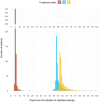Real-world effectiveness of cladribine as an escalation strategy for MS: Insights from the Czech nationwide ReMuS registry
- PMID: 39055049
- PMCID: PMC11271105
- DOI: 10.1177/11795735241262743
Real-world effectiveness of cladribine as an escalation strategy for MS: Insights from the Czech nationwide ReMuS registry
Abstract
Background: Cladribine, a selective immune reconstitution therapy, is approved for the treatment of adult patients with highly active multiple sclerosis (MS).
Objectives: Provide experience with cladribine therapy in a real-world setting.
Methods: This is a registry-based retrospective observational cohort study. First, using data from the Czech nationwide registry ReMuS, we analysed patients who initiated cladribine from September 1, 2018 to December 31, 2021. Second, we analysed a subgroup of patients who initiated cladribine between September 1, 2018 to June 30, 2020, thus possessing a follow-up period of at least 2 years. We evaluated demographic and MS characteristics including disease-modifying therapies (DMTs) before and after cladribine administration, relapses, Expanded Disability Status Scale (EDSS), and adherence.
Results: In total, 617 patients (335 with follow-up of at least 2 years) started cladribine therapy in the study period (mean age 37.0, mean disease duration 8.4 years, 74.1% females). In most cases, cladribine was administered as a second-line drug, a total of 80.7% had been escalated from a platform DMT. During 2 years before cladribine initiation, the average annualised relapse rate (ARR) was .67. Following cladribine initiation, the ARR decreased to .28 in the first year and .22 in the second year. Overall, across the entire two-year treatment period, 69.0% of patients were relapse-free and the average ARR was .25. As for EDSS development, the median baseline EDSS was 2.5 and remained stable even after 24 months. The adherence to treatment ranged of around 90%.
Conclusion: This nationwide study confirms the efficacy of cladribine in real-world settings, especially in patients who are not treatment-naïve. In addition, the study shows an exceptionally high adherence rate, a finding that underscores the invaluable role of cladribine, but also the value of registry-based studies in capturing real-world clinical practice.
Keywords: Cladribine; adherence; annualised relapse rate; expanded disability status scale; high-efficacy disease-modifying therapy; multiple sclerosis.
© The Author(s) 2024.
Conflict of interest statement
The authors declared potential conflicts of interest with respect to the research, authorship and/or publication of this article as following: PP received compensations for travel, speaker honoraria and consultant fees from Biogen Idec, Novartis, Merck Serono, Roche, Sanofi Genzyme. JD has nothing to disclose. DH received compensations for travel, speaker honoraria and consultant fees from Biogen Idec, Novartis, Merck Serono, Roche, Sanofi Genzyme, Teva and Janssen Cilag. MP received compensations for travel, speaker honoraria and consultant fees from Biogen Idec, Novartis, Merck Serono, Roche, Sanofi Genzyme, Teva and Janssen Cilag. AM has nothing to disclose. DM has nothing to disclose. ZP received compensations for travel, speaker honoraria and consultant fees from Biogen Idec, Novartis, Merck Serono, Roche, Sanofi Genzyme, Teva and Janssen Cilag. MV received compensations for travel, speaker honoraria and consultant fees from Biogen Idec, Novartis, Merck Serono, Roche, Sanofi Genzyme, Teva and Janssen Cilag. ER received compensations for travel, speaker honoraria and consultant fees from Biogen Idec, Novartis, Merck Serono, Roche, Sanofi Genzyme, Teva and Janssen Cilag. IS received compensations for travel, speaker honoraria and consultant fees from Biogen Idec, Novartis, Merck Serono, Roche, Sanofi Genzyme, Teva and Janssen Cilag. JL received compensations for travel, speaker honoraria and consultant fees from Biogen Idec, Novartis, Merck Serono, Roche, Sanofi Genzyme, Teva and Janssen Cilag. JM received compensations for travel, speaker honoraria and consultant fees from Biogen Idec, Novartis, Merck Serono, Roche, Sanofi Genzyme, Teva and Janssen Cilag. PS received compensations for travel, speaker honoraria and consultant fees from Biogen Idec, Novartis, Merck Serono, Roche, Sanofi Genzyme, Teva and Janssen Cilag. MG received compensations for travel, speaker honoraria and consultant fees from Biogen Idec, Novartis, Merck Serono, Roche, Sanofi Genzyme, Teva and Janssen Cilag. AM received compensations for travel, speaker honoraria and consultant fees from Biogen Idec, Novartis, Merck Serono, Roche, Sanofi Genzyme, Teva and Janssen Cilag. JA received compensations for travel, speaker honoraria and consultant fees from Biogen Idec, Novartis, Merck Serono, Roche, Sanofi Genzyme, Teva and Janssen Cilag. PH received compensations for travel, speaker honoraria and consultant fees from Biogen Idec, Novartis, Merck Serono, Roche, Sanofi Genzyme, Teva and Janssen Cilag. RA received compensations for travel, speaker honoraria and consultant fees from Biogen Idec, Novartis, Merck Serono, Roche, Sanofi Genzyme, Teva and Janssen Cilag. MD received compensations for travel, speaker honoraria and consultant fees from Biogen Idec, Novartis, Merck Serono, Roche, Sanofi Genzyme, Teva and Janssen Cilag. EKH received compensations for travel, speaker honoraria and consultant fees from Biogen Idec, Novartis, Merck Serono, Roche, Sanofi Genzyme, Teva and Janssen Cilag. DS received compensations for travel, speaker honoraria and consultant fees from Biogen Idec, Novartis, Merck Serono, Roche, Sanofi Genzyme, Teva and Janssen Cilag.
Figures
References
-
- Mavenclad EMA. INN-Cladribine. Amsterdam, Netherlands: European Medicines Agency; 2017. https://www.ema.europa.eu/en/documents/product-information/mavenclad-epa.... accessed 30 June 2023.
-
- FDA. FDA Approves New Oral Treatment for Multiple Sclerosis. Maryland, USA: Food and Drug Administration. Silver Spring; 2019. https://www.fda.gov/news-events/press-announcements/fda-approves-new-ora.... accessed 30 June 2023.
-
- Giovannoni G, Comi G, Cook S, et al. A placebo-controlled trial of oral cladribine for relapsing multiple sclerosis. N Engl J Med. 2010;362:416-426. - PubMed
-
- Giovannoni G, Soelberg Sorensen P, Cook S, et al. Safety and efficacy of cladribine tablets in patients with relapsing-remitting multiple sclerosis: results from the randomised extension trial of the CLARITY study. Mult Scler. 2018;24:1594-1604. - PubMed
-
- Leist TP, Comi G, Cree BA, et al. Effect of oral cladribine on time to conversion to clinically definite multiple sclerosis in patients with a first demyelinating event (ORACLE MS): a phase 3 randomised trial. Lancet Neurol. 2014;13:257-267. - PubMed
LinkOut - more resources
Full Text Sources
Research Materials



